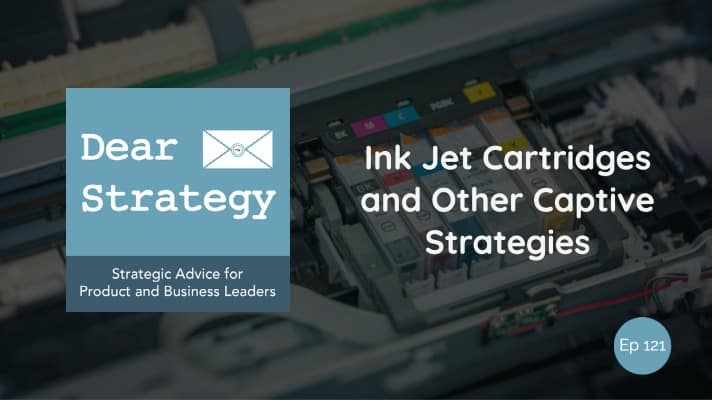On this episode of Dear Strategy, we analyze the practice of charging as much for the ink jet cartridges as for the printer itself. It’s called “captive pricing” and, just as the name implies it’s a strategy that’s not exactly designed with the customer in mind! We’ll talk about why this model exists and whether it’s actually a good strategy for companies to take over the long-term.
Believe it or not, this week’s story is not some lame excuse for me to go on a rant about the price of ink-jet cartridges. Yes, I think it’s highway robbery to charge what some of these companies have been charging for their cartridges. And, yes, it pisses me off when I’m limited to buying only one manufacturer’s brand of ink. And, of course I get upset when I don’t really know how much ink is actually left in a cartridge that I’m being warned to replace. And, no, I don’t believe that anything I’m being told by the manufacturers of ink jet printers is 100% accurate. But none of that is the point of this particular post. Instead, I want to talk about why companies take this approach to begin with and, more importantly, why this particular strategy with this particular product may be coming to an end.
What we’re talking about with these inkjet cartridges is a strategy called “captive pricing.” That’s when a company charges you a relatively low price for an item that relies on relatively high-priced other items to keep it running. Of course, inkjet printers, together with inkjet cartridges, are the most obvious example of this. But other examples include razors and razor blades, coffee makers and coffee pods, and even, to some extent, video game systems and video games. You might even put anything that uses batteries into this category, although one of the distinguishing characteristics of captive pricing is that the same company profits from both the initial purchase and the products that are needed to support that initial purchase. So, using that definition, unless the batteries were proprietary, they probably wouldn’t qualify under the captive pricing umbrella.
So, the real question here is around whether or not captive pricing is a good thing. I mean, clearly it benefits the manufacturers since, by its very nature, captive pricing allows them to generate recurring revenues long after an initial product has been sold. But how about for the consumers? How can this possibly be good for them?
Well, despite the name, captive pricing isn’t always all bad for consumers either. In reality, it’s not really “captivity” if the consumer can walk away at any time. So as long as both parties are getting value out of the relationship, then things may not really be as bad as they sound. Take a video game system, for example. As consumers, we rarely feel like we’re being “trapped” by our gaming systems – mostly because we’re getting a pretty decent value for our money. Paying a few hundred dollars for what is, essentially, a mini-computer; complete with a hard drive, high-powered audio and graphics capabilities, full access to internet and streaming services, and the ability to play a wide-variety of high-powered games – that doesn’t sound too bad when you put it all together. And then paying around $50 for a movie-quality game that can be played over and over again with literally an endless number of possible scenarios and outcomes – well, that sounds pretty reasonable as well. OK, maybe it’s not everyone’s cup of tea. But, based on what the games can do and what they probably cost to produce, I think most consumers would say that the pricing, in this case, is pretty much aligned with what they would expect to pay.
“As long as both parties are getting value out of the relationship, then things may not really be as bad as they sound.”
Now let’s move over to the world of inkjet cartridges. The printers are certainly priced reasonably. And for good reason since most of these devices are probably being priced with fairly slim margins. But those cartridges! I mean, they’re filled with ink for goodness sake! We pretty much know what ink would cost if we were able to buy it from a third party. And we also know that most of the inkjet manufacturers have put “safeguards” in place to prevent us from taking advantage of those otherwise reasonably priced alternatives. In that way, we truly are being held captive to a pricing model that we intuitively know is overinflated. Can we walk away? Sure – but to what alternative? So, in the end, we end up feeling gouged. And that’s exactly where the problem comes in.
And that’s also the entire point. I mean, it’s right there in the name! When captive pricing is practiced in such a way that consumers feel like they actually are being held captive, it simply won’t be sustainable over the long term. It may yield short-term profits, and that “short-term” may last for a pretty long time before someone or something comes into the marketplace to alleviate that pain point. But it will eventually happen. And, when it does, it could cause immeasurable damage to the companies that took advantage of that truly captive pricing model to begin with.
Of course, when captive pricing is practiced in such a way that consumers don’t feel like they’re being treated unfairly – like when the pricing paid matches the value received, or when there are many different available choices at a number of different price points – then the reaction probably won’t be so bad. Why? Because, in those cases, the relationship is mutually-beneficial – which means it really isn’t “captive” at all. Or maybe it’s “captive by choice” – which, granted, only sounds marginally better. But I think you get the idea.
The point is, even though captive pricing may be good for a manufacturer’s bottom line, it also has to represent a relationship that the consumer both knowingly and happily enters into. The minute they feel trapped or somehow treated unfairly, then your model is sure to be disrupted at some point in the future. Granted, you may be able to make a whole lot of money by the time it gets corrected. But, personally, I’d prefer to trade short-term margin for long-term trust any day of the week. And I think most consumers would expect other companies to feel exactly the same way.
So where are we now with the whole inkjet situation? Well, around 5 years ago, so-called “supertank” printers were introduced to the marketplace. This technology utilizes a system of tanks and bottles that allow consumers to replenish their ink at a fraction of the price of replaceable cartridges. And, needless to say, the technology has taken off. So the printer costs a bit more, but the ink costs a whole lot less. And suddenly everything seems right with the world. Which, at least in my opinion, is just as it should be – and, somehow, the way it always seems to end up.
Listen to the podcast episode
Dear Strategy: Episode 121

Are you interested in strategy workshops for your product managers or business leaders? If so, please be sure to visit Strategy Generation Company by clicking the link below:
 Bob Caporale is the founder of Strategy Generation Company, the author of Creative Strategy Generation and the host of the Dear Strategy podcast. You can learn more about his work by visiting bobcaporale.com.
Bob Caporale is the founder of Strategy Generation Company, the author of Creative Strategy Generation and the host of the Dear Strategy podcast. You can learn more about his work by visiting bobcaporale.com.







